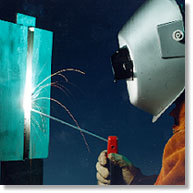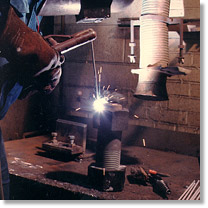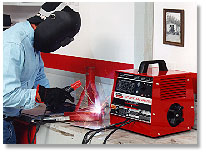Low Hydrogen Porosity
Stick welding porosity in a weld is considered poor quality. Porosity may or may not be visible to the naked eye. Occasionally porosity can be found in the face of the weld - sometimes the face may appear porosity free, but deep inside the weld porosity may exist. Porosity looks "sponge like" or like tiny bubbles in the weld. Porosity in a weld can be located using several different methods of non-destructive testing, such as radiographic (x-ray), UT (ultrasonic) and die penetrate.
"...strike the arc, then lift the electrode up for a moment or two, allowing a few drops of electrode to fall from the tip."
Although some porosity found at the beginning of a weld made with low hydrogen electrodes is not always apparent, it is possible and the solution itself may be simple. Often, even with an experienced welder, weld testing will show slight porosity at the beginning of a weld for no apparent reason. Porosity is often found when using low-hydrogen electrodes such as E-7018, and it may be difficult to establish why this occurs.
In order to understand the real cause, it is necessary to look at the way stick electrodes are manufactured, as well as how they are used in the field. The steel core wire, as we know, conducts electrical current from the electrode holder to the work . It also melts to become the filler metal. The chemical coating that forms the flux layer is extruded on to the steel core wire and baked in a controlled oven to remove moisture. The flux coatings major task is to vaporize and form a shielding gas to protect the weld puddle from nitrogen, hydrogen and oxygen.
During manufacturing, after the coating is applied and it is still soft and pliable, a set of brushes removes coating to accommodate the electrode holder. Another set of brushes slightly tapers the work end of the electrode to expose the end of the steel core wire. This exposed end allows a short circuit to be established when it touches the work at the start of the weld. As txhe weld progresses, the steel wire burns slightly up inside the flux (approximately 1/8 of an inch), so the coating melts to form the necessary shielding gas. Striking a new electrode, however, the tapered coating at the end of the electrode provides only minimal shielding since some of the coating was intentionally removed to accommodate easier arc starting. Therefore, if the operator lowers the electrode into the puddle immediately, some porosity may result at the beginning of the weld, which is caused by insufficient amount of coating on the steel core wire.
This condition also exists when re-striking an electrode that has already been used. Before striking an arc, the welder frequently taps the end of the electrode on the ground to break away flux at the tip. Breaking away the flux to expose the steel core wire, while helping to achieve the short circuit necessary to start the arc, creates conditions for improper arc shielding, sometimes resulting in porosity at the start of the weld. This practice is much more common with low hydrogen electrodes, since the core wire melts up inside the flux coating. Electrodes such as E-6010 and E-6011 use organic coatings (paper), which the coating tends to burn back enough to leave the end of the core wire exposed.
This type of porosity can be avoided if the operator is trained to strike the arc correctly. Immediately after establishing the arc, lift the electrode up a short distance from the work and holding it there for a second or two, allow a few drops of molten steel to fall from the tip of the electrode. The arc will bring the tip of the electrode up to operating temperature quickly, enabling the core wire to burn up inside the flux coating and initiate the gassing effect of the flux. Then, when the electrode is lowered to the work, the weld will be properly shielded, and porosity will be minimized.
Proper training is always important to achieving good results in welding. Training is even more critical when dealing with low hydrogen electrodes. A little understanding of how these electrodes differ and the consequences of improper electrode handling will pay big dividends in better weld quality and fewer porosity defects.



